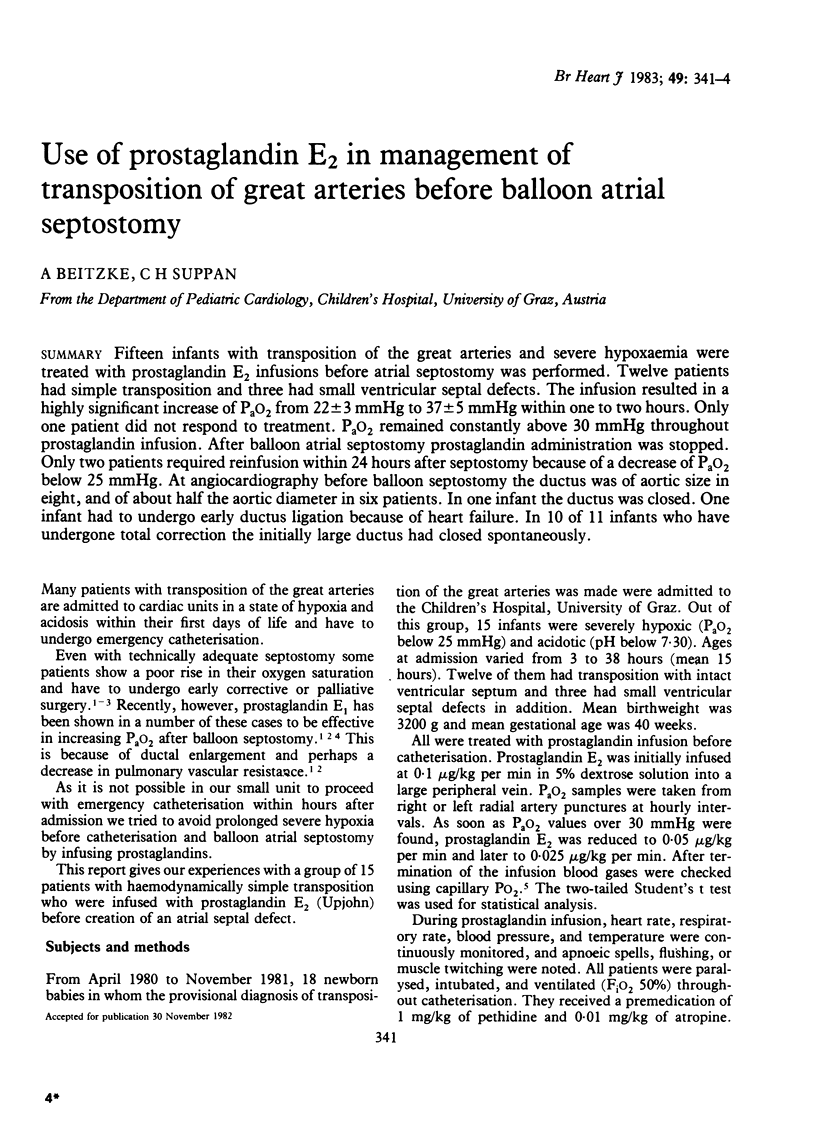Abstract
Fifteen infants with transposition of the great arteries and severe hypoxaemia were treated with prostaglandin E2 infusions before atrial septostomy was performed. Twelve patients had simple transposition and three had small ventricular septal defects. The infusion resulted in a highly significant increase of PaO2 from 22 +/- 3 mmHg to 37 +/- 5 mmHg within one to two hours. Only one patient did not respond to treatment. PaO2 remained constantly above 30 mmHg throughout prostaglandin infusion. After balloon atrial septostomy prostaglandin administration was stopped. Only two patients required reinfusion within 24 hours after septostomy because of a decrease of PaO2 below 25 mmHg. At angiocardiography before balloon septostomy the ductus was of aortic size in eight, and of about half the aortic diameter in six patients. In one infant the ductus was closed. One infant had to undergo early ductus ligation because of heart failure. In 10 of 11 infants who have undergone total correction the initially large ductus had closed spontaneously.
Full text
PDF



Selected References
These references are in PubMed. This may not be the complete list of references from this article.
- Beitzke A. Prostaglandin E-2 bei cyanotischen Herzfehlern im Neugeborenenalter. Klin Padiatr. 1981 Sep;193(5):385–389. doi: 10.1055/s-2008-1034504. [DOI] [PubMed] [Google Scholar]
- Benson L. N., Olley P. M., Patel R. G., Coceani F., Rowe R. D. Role of prostaglandin E1 infusion in the management of transposition of the great arteries. Am J Cardiol. 1979 Oct;44(4):691–696. doi: 10.1016/0002-9149(79)90289-3. [DOI] [PubMed] [Google Scholar]
- Driscoll D. J., Kugler J. D., Nihill M. R., McNamara D. G. The use of prostaglandin E1 in a critically ill infant with transposition of the great arteries. J Pediatr. 1979 Aug;95(2):259–261. [PubMed] [Google Scholar]
- Freed M. D., Heymann M. A., Lewis A. B., Roehl S. L., Kensey R. C. Prostaglandin E1 infants with ductus arteriosus-dependent congenital heart disease. Circulation. 1981 Nov;64(5):899–905. doi: 10.1161/01.cir.64.5.899. [DOI] [PubMed] [Google Scholar]
- Hawker R. E., Freedom R. M., Rowe R. D., Krovetz L. J. Persistence of the fetal pattern of circulation in transposition of the great arteries. Johns Hopkins Med J. 1974 Feb;134(2):107–117. [PubMed] [Google Scholar]
- Henry C. G., Goldring D., Hartmann A. F., Weldon C. S., Strauss A. W. Treatment of d-transposition of the great arteries: management of hypoxemia after balloon atrial septostomy. Am J Cardiol. 1981 Feb;47(2):299–306. doi: 10.1016/0002-9149(81)90401-x. [DOI] [PubMed] [Google Scholar]
- Lang P., Freed M. D., Bierman F. Z., Norwood W. I., Jr, Nadas A. S. Use of prostaglandin E1 in infants with d-transposition of the great arteries and intact ventricular septum. Am J Cardiol. 1979 Jul;44(1):76–81. doi: 10.1016/0002-9149(79)90253-4. [DOI] [PubMed] [Google Scholar]
- Lewis A. B., Freed M. D., Heymann M. A., Roehl S. L., Kensey R. C. Side effects of therapy with prostaglandin E1 in infants with critical congenital heart disease. Circulation. 1981 Nov;64(5):893–898. doi: 10.1161/01.cir.64.5.893. [DOI] [PubMed] [Google Scholar]
- Mair D. D., Ritter D. G. Factors influencing intercirculatory mixing in patients with complete transposition of the great arteries. Am J Cardiol. 1972 Nov 8;30(6):653–658. doi: 10.1016/0002-9149(72)90604-2. [DOI] [PubMed] [Google Scholar]
- Pitlick P., French J. W., Maze A., Kimble K. J., Ariagno R. L., Reitz B. A. Long-term low-dose prostaglandin E1 administration. J Pediatr. 1980 Feb;96(2):318–320. doi: 10.1016/s0022-3476(80)80838-9. [DOI] [PubMed] [Google Scholar]
- Stamm S. J. Reliability of capillary blood for the measurement of pO2 and O2 saturation. Dis Chest. 1967 Aug;52(2):191–194. doi: 10.1378/chest.52.2.191. [DOI] [PubMed] [Google Scholar]


